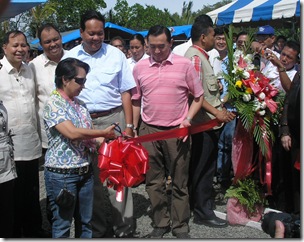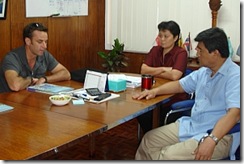
A new marine fish hatchery in Misamis Occidental is now operational through the joint efforts of the provincial government, the Australian government and the Southeast Asian Fisheries Development Center (SEAFDEC) through its Aquaculture Department (AQD). Headed by Dr. Joebert Toledo, AQD provided the technical support, technology and supervision over the project.
The P8.8-million hatchery was recently inaugurated by President Gloria Arroyo along with DA Secretary Arthur Yap, Misamis Occidental Gov. Loreto Ocampos and Australian Ambassador to the Philippines Rod Smith.
The project, which forms part of the Misamis Occidental Aquaculture Park (MOAP), aims to create direct and indirect employment for coastal fish farmers; promote aquaculture; and help the province become a major provider of agri-aqua products in Northern Mindanao.
The hatchery facilities were built through a joint partnership with the Australian government through the Philippines-Australia Local Sustainability (PALS) program, which allocated P5.56 million for the project.
The Misamis Occidental provincial government shouldered the P2.44 million counterpart fund to complete the hatchery.
"The hatchery is expected to produce an annual output of 576,000 grouper (lapu-lapu or pugapo) fry, which will help guarantee a stable supply of fish for the province," Toledo said in a report to Yap. "Milkfish, red snapper, crablets, seabass, seahorse and other high-value species are also expected to be produced in the hatchery."
The facility is capable of supporting 32 grouper grow-out fish cages that will be placed along the 169-kilometer coastline of Panguil Bay and Murcillagos Bay, Toledo said.
He said this hatchery houses two 160-tonner broodstock tanks supported by a 135-ton reservoir tank. Six 15-tonner Chlorella and rotifer tanks will supply natural food for the 8 larval tanks that will raise 12,000 fry each per run or every 60 days
Director Malcolm Sarmiento of the Bureau of Fisheries and Aquatic Resources earlier pointed out that mariculture parks are not only practical and economical but are also ecology-friendly.
For instance, he said, mangrove trees don't need to be cut to raise bangus in a fish cage. Raising fish in a mariculture park is also cheaper because it costs only about P150,000 to put up a sea cage while development cost for a hectare of fishpond will reach about P1 million.
Moreover, yields can reach as much as 5 tons in a 10x10 meter sea cage inside a mariculture park, which is the same as in a one-hectare fish pond, Sarmiento added.
With production cost of P70.00-P75.00 per kilo, a fish farmer could easily earn some P90,000.00 per cage or a total of P180,000.00 for two cropping periods per year.
To further increase his earnings, a fish farmer can also grow danggit or samaral in seacages tandem with bangus under a system called aqua-polyculture. After one cropping with 1,680 pieces fingerlings, danggit could grow to an estimated 100 kilos, which could easily fetch an additional cash of P8,800.
The DA has been working closely with the SEAFDEC in several fisheries development projects, including the supervision over the culture and importation of Peneaus vannamei or Pacific white shrimp and a three-year collaborative "fish-tagging" project that will focus on determining the migration patterns of small pelagic fishes with the end in view of crafting a regional plan to guarantee the sustainability of these marine resources. - DA Press Office


